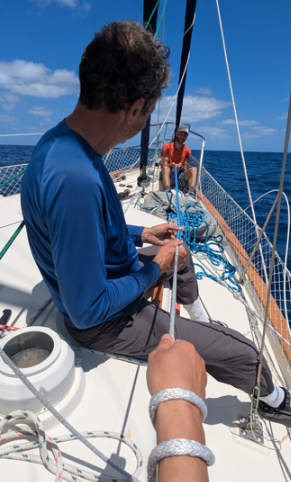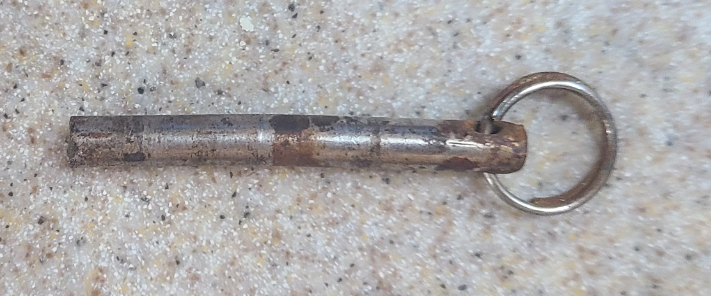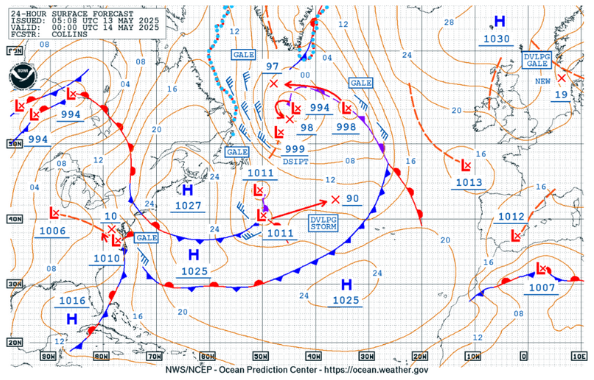Date: Tuesday 13/05/25 - Time: 17:37 Bermuda time
Position 35:9.57N 50:31.42W
COG 100T SOG 4.3kt, Wind 282T 10
kt,
Temperatures: Air 20C, Sea 20.0 C
Barometer: 1024.3 hPa - decreasing
Sailed distance since departure: 797 NM
Percentage trip: 42.8 %
Last 24h Sailed Distance: 771 NM
Time since departure: 5d 5h 37 m
Average Speed since departure: 6.34
kt
Average VMG since departure: 5.70
kt
Average VMG speed last 24h: 4.99 kt
Intention: sail to Flores
Distance to End on rhumb line: 957 NM
ETA : Tuesday May 20, @ 09:00
Detailed Track:
https://share.garmin.com/svBlueNote
The day started with beautiful blue sky and sun shining.
For the first time since leaving Bermuda we come across other
ships:
a Norwegian oil-rig tug boat and two cargo ships all heading west
and all within one hour.
We set the code-zero that with the 10 kts wind was letting us
sailing at 5 kts.
Then before lunch the wind decreased to 5 kts, so we decided to
start the engine (first time since we left Bermuda -
since solar and wind generator were sufficient to recharge
batteries with energy to spare for heating water for shower)
bring the mainsail down and furled the code-zero in and bring the
code zero down back down.
This evening the wind from a deep low pressure up North will start
to affect us and we should be able to go back sailing.
Breakage #1)
As we were bringing down the code-zero we discovered that the
chafing guard of the halyard had broken and only the core was
holding the weight of the code zero.
Unfortunately we could not bringing it down because the chafing
guard was piling-up making the halyard very thick.
So we had to bring the code zero up again and "milk" the chafing
guard (or as it is called in Italian "il calzino") away from the
core.
A process that took more than one hour considering the length of
the halyard.
At the end we were left with the core of the original spinnaker
halyard that will serve as messenger for a new halyard.
Not sure why the chafing guard broke. There was no signs of
chafing.

Three people job trying to remove the chafing guard from the
halyard.
Breakage #2)
As we were working on milking the halyard, in the rolling boat due
to swells, I leaned against the top lifeline and "pop" it broke.
Likely I was fast enough to grab the wood handle on deck and not
fall overboard.
As pictures below shows a clear case of corrosion of the
stainless-steel cable hidden by the plastic cover.
A clear example why nowadays it is recommendation to have
lifelines in either dyneema or cable without plastic cover.
It's possible that the corrosion had happen to a section weakened
several years ago when at a marina that lifeline had hit a pillar
of a dock.
For now we replaced the broken top lifeline with a strong line
(dyneema ?) salvaged from the old life-raft that we had to
disposed in Oxford.

Point of breakage of the lifeline. The plastic was cat a bit to
exposed the cable.
Breakage #3)
When we took the mainsail down we had found a pin on deck. The pin
was holding the the section of the cart that slides in to the fast
track with the section attached to the sail.
We replaced it with a screw and a nylon locking nut. What had
broken (see photo below) is the head of the pin.
Surprising this is from the new doyle main sail that was hardly
used before.

The broken pin holding the two sections of one of the mainsail
carts. The pin head was on the left and is now missing. The pin
also looks a bit bended.

Namiru' e Nairobi eating their lunch.

Synopsis for the North-West Atlantic showing the deep low
pressure system that will bring winds to us but stay well north of
our 35 latitude.





